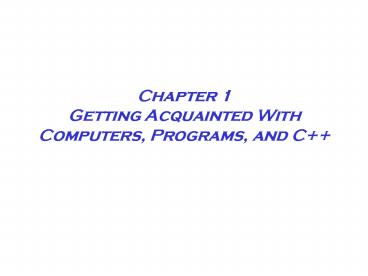Chapter 1 Getting Acquainted With Computers, Programs, and C - PowerPoint PPT Presentation
Title:
Chapter 1 Getting Acquainted With Computers, Programs, and C
Description:
Chapter 1. Primary Memory. Primary memory often is called main working memory. ... Chapter 1. Output. Output is what comes ... Chapter 1. High-Level Language ... – PowerPoint PPT presentation
Number of Views:40
Avg rating:3.0/5.0
Title: Chapter 1 Getting Acquainted With Computers, Programs, and C
1
Chapter 1Getting Acquainted With Computers,
Programs, and C
2
Chapter 1
- A Typical PC
3
Chapter 1
- The Hardware
4
Chapter 1
- The Central Processing Unit (CPU)The central
processing unit (CPU) is the brain and nerve
center of the entire system. This is where all of
the calculations and decisions are made. In a PC
system, the entire CPU is contained within a
single integrated circuit (IC) chip called a
microprocessor.
5
Chapter 1
6
Chapter 1
- Typical Operations Performed by the
ALU Addition - Subtraction ?
- Multiplication
- Division /
- Modulus (Remainder)
- Equal to
- Not equal to !
- Less than lt
- Less than or equal to lt
- Greater than gt
- Greater than or equal to gt
7
Chapter 1
- Primary MemoryPrimary memory often is called
main working memory. The reason for this is that
primary, or main, memory is used to store
programs and data while they are being worked,
or executed, by the CPU.
8
Chapter 1
- Binary Values bit 0 or 1
- byte 8 bits
- kilobyte(KB) 1024 bytes
- megabyte(MB) 1,048,576 bytes
- gigabyte(GB) 1,073,741,824 bytes
9
Chapter 1
10
Chapter 1
- Secondary MemorySecondary memory, sometimes
called bulk or mass storage, is used to hold
programs and data on a semi-permanent basis. The
most common types of secondary memory used in PC
systems are magnetic disks and CDs.
11
Chapter 1
- InputInput is what goes into the system. Input
devices are hardware devices that provide a means
of entering programs and data into the system.
The major input devices for a PC system are the
keyboard, mouse, and disk drive.
12
Chapter 1
- OutputOutput is what comes out of the system.
Output devices are hardware devices that provide
a means of getting data out of the system. The
four major output devices with which you will be
concerned are the display monitor, printer, disk
drive, and modem.
13
Chapter 1
- Loading and Saving Your C Programs
14
Chapter 1
- The Fetch/Execute CycleThe fetch/execute cycle
is what takes place when you run a program.
15
Chapter 1
- The SoftwareComputer software can be likened to
the driver of an automobile. Without the driver,
nothing happens. In other words, the computer
hardware by itself can do nothing. A set of
software instructions that tells the computer
what to do is called a computer program.
16
Chapter 1
- Machine LanguageAll of the hardware components
in a computer system, including the CPU, operate
on a language made up of binary 1s and 0s. A
CPU does not understand any other language.
17
Chapter 1
- Assembly LanguageAssembly language employs
alphabetic abbreviations called mnemonics that
are easily remembered by you, the programmer. For
instance, the mnemonic for addition is ADD, the
mnemonic for move is MOV, and so forth.
18
Chapter 1
- Operating SystemsAn operating system, or OS, is
the glue that binds the hardware to the
application software. Actually, an operating
system is a collection of software programs
dedicated to managing the resources of the
system.
19
Chapter 1
- High-Level LanguageA high-level language
consists of instructions, or statements, that are
similar to English and common mathematical
notation. When programming in a high-level
language, you do not have to concern yourself
with the specific instruction set of the CPU.
Rather, you can concentrate on solving the
problem at hand.
20
Chapter 1
- Language TranslationA source program is the one
that you write in the C language and that
normally has a file extension of .cpp. An object
program is the binary machine language program
generated by the C compiler, which always has a
file extension of .obj.
21
Chapter 1
- C Translation
22
Chapter 1
- Structured vs. Object-Oriented LanguagesThe C
language is a structured language that allows
complex problems to be solved using a modular,
top/down, approach. The C language contains the
C language for structured programming, but in
addition extends the C language to provide for
object-oriented programming (OOP).
23
Chapter 1
- Object-oriented programming (OOP) allows complex
problems to be solved using more natural objects
that model the way we humans think about things.
24
Chapter 1
- Hello World /
- NAME ANDREW C. STAUGAARD JR.
- CLASS CS1
- PROGRAM TITLE HELLO WORLD
- DATE 5/16/01
- THIS PROGRAM WILL DISPLAY THE MESSAGE "Hello
World" TO THE SYSTEM MONITOR - /
- //PREPROCESSOR SECTION
- include ltiostream.hgt //FOR cout
- //MAIN FUNCTION SECTION
- int main()
- //BEGIN MAIN FUNCTION BLOCK
- cout ltlt "Hello World" //DISPLAY MESSAGE TO
MONITOR - return 0
- //END MAIN FUNCTION BLOCK































